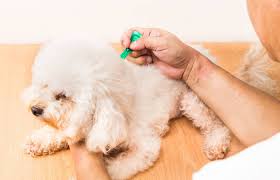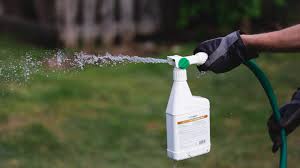Knock, knock, it’s summertime.
On saying summertime, we usually remember the pool and the off-leash walks in the woods to play with our dogs.
BBQ times, family gatherings, and going outside with your dog with no limitations are all fantastic things that happen mostly in summer.
But we can’t forget an essential little enemy waiting inside his hibernation to start coming out, which is “The Tick.” If you have a puppy, you are probably wondering when can puppies use flea collars?
Flea collars have proven to be one of the best options for your dog. Starting from 7 weeks old, your puppy can wear flea collars to protect himself against all ticks.
Every dog owner must deal with ticks daily. Whether you have an adult dog, a puppy, or a pregnant dog, or whether your dog is dewormed or not, dealing with ticks will be part of your routine.
While deworming helps your dog and protects him for fleas, vets advise having flea collars instead because they are more lasting, and they are safer. But, still, fighting insects in puppies is indeed harder than fighting fleas in large dogs.
When Can Puppies Wear Flea Collars?

Depending on the product, puppies can wear flea collars at seven weeks old. However, take care that it depends heavily on the product.
Some flea collars are made for large dogs only starting from 6 months old, and others can be used for young puppies. You have to carefully read the guide provided with the flea collar so that you make sure your dog is safe.
But why does it matter? Why do some products work for puppies and other for adults?
Well, this is a good question. Flea collars depend on the age because of the used effective substance inside it. While some of these effective substances may be toxic to young puppies, they may be quite reasonable for adults.
Just like how some food that you eat isn’t advised for newborns to eat because it may be toxic for them, some flea collars aren’t recommended for puppies.
As dogs grow older, their bodies become more robust and larger. That’s why they will eventually need a more reliable flea collar to fit their body size.
On the other hand, younger puppies have a small size, and you don’t need to worry about sturdy flea collars.
Another essential thing is allergies. You still don’t know what your puppy is allergic to, and he may be allergic to flea collars. That’s why you need to be careful not to use powerful ones to keep him safe.
Take into consideration as well that puppies are playful, and they will try to get this flea collar off their neck. Weaker flea collars aren’t as toxic as flea collars made for adults, and therefore, puppies can survive if they played with them (This doesn’t mean they are safe.)
That’s why I always recommend sticking to the recommended age and never think that the more powerful, the better because it may be the worse.
How Do Tick Removal Fragrances Work

Tick Removal Fragrances produce a very high-intensity lousy smell that can kill ticks or worms. Toxic substances produce this smell.
Some fragrances are more effective than others. For example, some are puppy-friendly, and the others aren’t. For example, Frontline is utterly safe on puppies; it’s lick-friendly, which means that puppies or dogs won’t be harmed by licking it.
However, some fragrances are deadly, and dogs should never lick them for any reason. Most likely, those fragrances are useful and can kill ticks fast.
While there is another similar way to protect your dog from ticks, by injecting him with a tick removal substance once every 6 months, I never recommend it.
Those shots are very harmful to the dog’s liver, and the continuous injection will lead to the dog’s death. That’s why you should never inject your pet with those shots except under the vet’s consultancy.
For me, I recommend having a tick removal such as Frontline, as this is safe. However, you have to read how long the fragrance is sufficient to ensure your dog is always safe.
How Do Flea Collars Work?
While Flea collars are more expensive than regular tick removal fragrances, I highly recommend them.
Flea Collars provide long effectiveness that can last up to six months. If you made some calculations, you would realize that they are cheaper in the long run than the typical methods.
The working idea is similar to the tick removal fragrances; they have a terrible smell that can kill ticks. However, the scent is always concentrated and highly better than ordinary methods.
That’s why I prefer them to the ordinary methods because they are more effective and many of them are puppy-friendly. Meaning that they are safe even if the puppy started biting on them (NOT RECOMMENDED AT ALL.)
However, there are many precautions for flea collars that you need to take into consideration.
Precautions To Take Before Putting A Puppy On A Flea Collar

While Flea collars are great, you have to take care of somethings:
- Remove Flea Collars while dogs are playing.
That’s because dog play usually accompanies some biting and chewing. Therefore it will be dangerous for dogs to play while Flea Collars on. - Water destroys Flea Collars.
That means that if your dog plays in the water while having a flea collar on, you will need to dump it. That’s because the effective substance in the Flea Collars doesn’t go along with water. - You need to remove Flea Collars regularly.
Some owners leave the Flea Collars on their dogs 24/7, and when they remove it, they will see a red ring around their dog’s neck.
That’s because tightening the Flea Collars around your dog’s neck for a prolonged time while cause red spots on his neck. - Don’t attach the leash to the Flea Collar.
Some owners think that it’s ok to treat the Flea Collar as a regular collar. By doing so, you are suffocating your dog, and if your dog was weak, he might die.
And Flea Collars are weak, and any strong pull can tear it. - Remove it before your dog goes to bed.
Let your dog’s neck have some free air; therefore, your dog won’t always have something around his neck. - Make sure that the collar isn’t loose.
Sometimes, owners prefer to leave the collar loose so that it doesn’t annoy the dog. However, many puppies are hyper and troublemakers. They can stick their head into something and can’t get their head back out.
That’s why I recommend keeping the collar around the dog’s neck while leaving a small space equal to 2 fingers. This way, you will be sure that this collar won’t get stuck to anything.
Are Flea Collars Safer Than Ordinary Methods?
I will be a liar to say yes or no.
We don’t have a sharp answer to this. The statistics of dogs suffering from both due to accidents are pretty much the same.
However, for a puppy, the safest thing to do is always to use puppy products. Whether Flea collars or flea removal fragrant, just make sure it’s a puppy-tolerant product.
Dog-Friendly Pesticides For Your Backyard

Your backyard can be attacked severely in summer by many types of fleas. That’s why you should always use a pesticide.
However, as you have a puppy, I am sure you are afraid to use anything that can harm him, especially that your puppy will definitely eat some grass.
That’s why I recommend this fantastic review article, which shows the best products that are safe for your backyard and for your puppy.
Why Should You Think About Removing Ticks? What Can They Do?
Fleas and ticks are little enemies who cause enormous health issues.
Before I tell you the exact issues that fleas can do to your dog, I want to share some statistics from reliable sources.
According to WHO, nearly 700 million people get a mosquito-borne illness each year, resulting in over one million deaths. Can you imagine that?
This little mosquito kills one million people annually and is classified as one of the deadliest animals.
When thinking about fleas and insects, most people overlook something significant. Fleas aren’t deadly at all. However, they are the type of animals that don’t die because of a disease.
That’s why a flea can carry AIDS, for example, and still survive. However, once this insect bites another person, AIDS will be passed to the person. So the danger of insects lies within what they carry and not within their bite.
When looking at the infections made by the ticks for dogs, we can find that they do the following:
- Tapeworms
- Murine Typhus
- Lyme Disease
- Rocky Mountain Spotted Fever
- Anaplasmosis
- Tick Paralysis
That’s a lot, and I believe we might have many more diseases. That’s why you always need to protect your puppy from ticks and fleas. Direct contact with your puppy’s blood can easily inject any microbe.
What To Do When Finding A Tick On Your Puppy?

On finding a tick in your puppy, you have to remove it quickly.
Bear in mind that ticks won’t transmit diseases immediately, but they take 24-36 hours to transmit viruses. So, if you removed the ticks quickly, you will keep your puppy safe.
Procedures to remove a tick/flea from a dog:
Time Needed: 5 minutes
- Use Tweezers
Tweezers are great for tick removal. I am highly against bare hands.
While you can use your bare hands, you are exposing yourself to the infected blood, which is harmful.
Instead of Tweezers, you can use tick removal gadgets, which you can find in lots of places like here. - Place the Tweezers around the tick and pull up gently.
Try to pull up vertically to make sure that the tick’s whole body is removed without being crushed inside the dog’s skin. - Clean the bite area.
You can use alcohol or pure soap and water. - Put the Tick in the toilet.
And flush it.
Now, there are some precautions that many people ignore, and they need to be taken into consideration.
- Don’t crush the tick.
Crushing the tick inside your dog’s blood might increase the emission of the harmful fluids. Therefore, you are increasing the probability of infecting the dog. - Ticks and fleas don’t die quickly; if you think that by throwing them in the trash, you get rid of them, you are wrong. Throw them in the toilet or in alcohol instead.
- Never use Vaseline, never use Vaseline, never use Vaseline.
- Using Vaseline or any substance to kill the tick inside your dog’s body is dangerous. You are telling the tick to let go of the harmful fluids inside him.
- While heat can kill ticks, it is preferable not to use a hairdryer on them.
- Generally, I don’t recommend killing a tick inside your dog’s body, take it out first.
Best Places To Look For A Tick/Flea On Your Puppy
When puppies start scratching themselves regularly, it’s a reliable sign for you that the puppy has fleas or ticks in this area.
Usually, you will find this area very wet due to the puppy’s teeth trying to remove the tick from it.
However, there are places where ticks prefer to stay there, those places are usually the places that puppies can’t reach by scratching or nipping:
- Between the dog’s toes.
- Around the anal area or his lower tail part.
- The ears
- Eyelids
- Groin
Those places are most likely to catch ticks or fleas rapidly. I recommend checking them regularly (you can check other parts as well quickly.) And always check the parts that the dog is periodically scratching.
conclusion
Flea Collars are tremendous, and indeed one of the best options for your little puppy. However, it comes with some precautions to take into consideration.
Make sure to use products that are safe and won’t hurt your puppy, and always follow the safety guidelines.
And don’t forget to check our latest articles!

